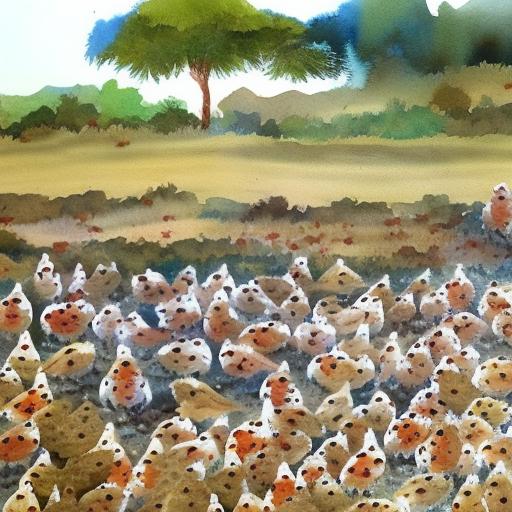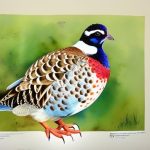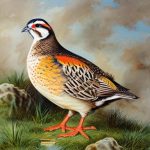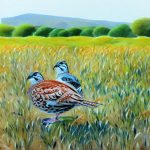The Manipur Bush Quail, scientifically known as Perdicula manipurensis, is a small bird species belonging to the family Phasianidae. This species is native to the Indian subcontinent, specifically found in the northeastern state of Manipur. The Manipur Bush Quail is known for its distinctive appearance and behavior, making it a fascinating subject for bird enthusiasts and researchers alike. With its unique characteristics and significance to the ecosystem, the Manipur Bush Quail is an important species that deserves attention and conservation efforts.
The Manipur Bush Quail is a small, ground-dwelling bird with a compact body and short tail. It has a mottled brown plumage with black and white markings, providing excellent camouflage in its natural habitat. The male and female quails have similar appearances, with the male being slightly larger in size. These birds have a distinct call that is often heard during the breeding season, consisting of a series of short, sharp notes. The Manipur Bush Quail is known for its secretive nature, often staying hidden in dense vegetation and only emerging to forage for food or during courtship displays. These unique characteristics make the Manipur Bush Quail a fascinating species to study and observe in the wild.
Key Takeaways
- Manipur Bush Quail is a breed of quail found in the northeastern state of Manipur, India.
- These quails are known for their small size, distinctive plumage, and secretive nature.
- They are found in grasslands, agricultural fields, and scrub habitats in Manipur and parts of Myanmar.
- Breeding and reproduction of Manipur Bush Quail occurs during the monsoon season, with the female laying eggs in a shallow depression on the ground.
- The conservation status of Manipur Bush Quail is currently listed as “Vulnerable” due to habitat loss and hunting, and conservation efforts are being made to protect their remaining habitats.
Characteristics of Manipur Bush Quail
The Manipur Bush Quail is a small bird species, with an average length of 16-18 cm and weighing around 50-60 grams. It has a rounded body shape, short wings, and a short tail, which allows it to maneuver through dense vegetation with ease. The plumage of the Manipur Bush Quail is predominantly brown with black and white markings, providing excellent camouflage in its natural habitat. The male and female quails have similar appearances, with the male being slightly larger in size. These birds have a distinct call that is often heard during the breeding season, consisting of a series of short, sharp notes. The Manipur Bush Quail is known for its secretive nature, often staying hidden in dense vegetation and only emerging to forage for food or during courtship displays.
The Manipur Bush Quail is primarily a ground-dwelling bird, foraging for seeds, insects, and small invertebrates in the leaf litter and undergrowth of its habitat. It is a shy and elusive species, often staying hidden in dense vegetation and relying on its camouflage to avoid predators. The quails are known to form small groups or pairs during the breeding season, engaging in courtship displays and vocalizations to attract mates. The breeding season for the Manipur Bush Quail typically occurs during the monsoon months, with the female laying a clutch of eggs in a shallow depression on the ground. These unique characteristics make the Manipur Bush Quail a fascinating species to study and observe in the wild.
Habitat and Distribution
The Manipur Bush Quail is endemic to the northeastern state of Manipur in India, where it inhabits dense grasslands, scrublands, and open woodlands. These birds are typically found in areas with thick undergrowth and dense vegetation, providing them with cover and protection from predators. The Manipur Bush Quail prefers habitats with a mix of grassy patches, shrubs, and small trees, where they can forage for food and seek shelter. The distribution of the Manipur Bush Quail is limited to specific regions within Manipur, making it a localized and unique species within its range.
The habitat of the Manipur Bush Quail is under threat due to habitat loss and degradation caused by human activities such as agriculture, logging, and infrastructure development. Deforestation and land conversion have resulted in the loss of suitable habitat for the quails, leading to population declines and fragmentation. Conservation efforts are crucial to protect and restore the habitats of the Manipur Bush Quail, ensuring their survival in the wild. Understanding the distribution and habitat requirements of these birds is essential for implementing effective conservation strategies to safeguard their populations.
Breeding and Reproduction
The breeding behavior of the Manipur Bush Quail is an intriguing aspect of their biology, characterized by courtship displays and vocalizations during the mating season. The breeding season for these birds typically occurs during the monsoon months, when there is an abundance of food resources and suitable nesting sites. The male quails engage in courtship displays to attract females, which may include puffing up their plumage, bobbing their heads, and vocalizing with distinctive calls. Once a pair has formed, the female will lay a clutch of eggs in a shallow depression on the ground, usually concealed within dense vegetation for protection.
The incubation period for the eggs lasts around 16-18 days, during which the female remains dedicated to keeping the eggs warm and protected. After hatching, the chicks are precocial and able to move around shortly after birth, although they still rely on their parents for protection and guidance. The parents will lead their offspring to suitable foraging areas and provide them with food until they are independent. Understanding the breeding and reproductive biology of the Manipur Bush Quail is essential for conservation efforts, as it provides valuable insights into their population dynamics and reproductive success.
Conservation Status
The conservation status of the Manipur Bush Quail is currently listed as “Vulnerable” on the IUCN Red List of Threatened Species, indicating that it faces a high risk of extinction in the wild. The population trend of these birds is decreasing, primarily due to habitat loss, degradation, and hunting pressure. The limited distribution range of the Manipur Bush Quail makes it particularly vulnerable to threats such as habitat destruction and fragmentation. Conservation efforts are crucial to address these threats and ensure the long-term survival of this unique species.
Several conservation measures have been proposed to protect the Manipur Bush Quail, including habitat restoration, protected area management, and community-based conservation initiatives. These efforts aim to conserve the remaining habitats of the quails and mitigate the impacts of human activities on their populations. Additionally, raising awareness about the importance of conserving the Manipur Bush Quail and its habitat is essential for garnering support from local communities and stakeholders. By implementing targeted conservation actions and monitoring the populations of these birds, we can work towards securing a sustainable future for the Manipur Bush Quail.
Importance to the Ecosystem

The Manipur Bush Quail plays a significant role in its ecosystem as a seed disperser and insect predator. As ground-dwelling birds, they forage for seeds, insects, and small invertebrates in the leaf litter and undergrowth of their habitat. By consuming seeds and insects, they help regulate insect populations and contribute to seed dispersal, which is essential for maintaining plant diversity in their ecosystem. The presence of Manipur Bush Quail also indicates the health of their habitat, as they rely on diverse vegetation cover for food and shelter.
Furthermore, these birds are an important prey species for local predators such as snakes, raptors, and small mammals. Their presence in the food web contributes to the overall biodiversity and ecological balance of their ecosystem. Protecting the populations of Manipur Bush Quail is not only important for their survival but also for maintaining the ecological integrity of their habitats. By conserving these birds, we can help preserve the functioning of their ecosystems and ensure a healthy balance of species interactions.
Threats and Conservation Efforts
The Manipur Bush Quail faces several threats that jeopardize its survival in the wild, including habitat loss, degradation, hunting pressure, and climate change. Deforestation and land conversion for agriculture and infrastructure development have resulted in the loss of suitable habitat for these birds, leading to population declines and fragmentation. Additionally, hunting pressure poses a significant threat to their populations, as they are often targeted for food or sport in some areas.
Conservation efforts are crucial to address these threats and ensure the long-term survival of the Manipur Bush Quail. Habitat restoration and protected area management are essential strategies for conserving their remaining habitats and mitigating the impacts of human activities. Community-based conservation initiatives that involve local communities in habitat protection and monitoring can also contribute to safeguarding these birds. Furthermore, raising awareness about the importance of conserving the Manipur Bush Quail and its habitat is essential for garnering support from stakeholders and policymakers.
In conclusion, the Manipur Bush Quail is a unique bird species with distinctive characteristics that make it an important subject for conservation efforts. Its limited distribution range within Manipur makes it particularly vulnerable to threats such as habitat loss, degradation, hunting pressure, and climate change. By understanding its biology, habitat requirements, and ecological importance, we can work towards implementing effective conservation measures to protect this species and ensure its survival in the wild. It is crucial to prioritize conservation actions that address these threats and involve local communities in safeguarding the habitats of the Manipur Bush Quail for future generations to appreciate and enjoy.
If you’re interested in learning more about the breeding habits of quails, you might want to check out an article on Poultry Wizard that discusses whether quails sit on their eggs. This article provides valuable insights into the nesting and breeding behaviors of quails, which can be particularly helpful for those looking to breed Manipur bush quail or any other quail breeds. You can find the article here.
FAQs
What is the Manipur Bush Quail?
The Manipur Bush Quail is a species of bird belonging to the quail family. It is found in the Indian state of Manipur and is known for its distinctive breeding habits and behaviors.
What are the breeding habits of the Manipur Bush Quail?
The Manipur Bush Quail breeds during the monsoon season, which typically occurs from June to September. During this time, the male quails perform elaborate courtship displays to attract females.
Where does the Manipur Bush Quail build its nests?
The Manipur Bush Quail builds its nests on the ground, typically in grassy or shrubby areas. The female quail lays her eggs in the nest, and both parents take turns incubating the eggs and caring for the chicks.
What is the conservation status of the Manipur Bush Quail?
The Manipur Bush Quail is currently listed as “Vulnerable” on the IUCN Red List of Threatened Species. Its population is declining due to habitat loss and hunting, and conservation efforts are being made to protect this species.
Meet Walter, the feathered-friend fanatic of Florida! Nestled in the sunshine state, Walter struts through life with his feathered companions, clucking his way to happiness. With a coop that’s fancier than a five-star hotel, he’s the Don Juan of the chicken world. When he’s not teaching his hens to do the cha-cha, you’ll find him in a heated debate with his prized rooster, Sir Clucks-a-Lot. Walter’s poultry passion is no yolk; he’s the sunny-side-up guy you never knew you needed in your flock of friends!







